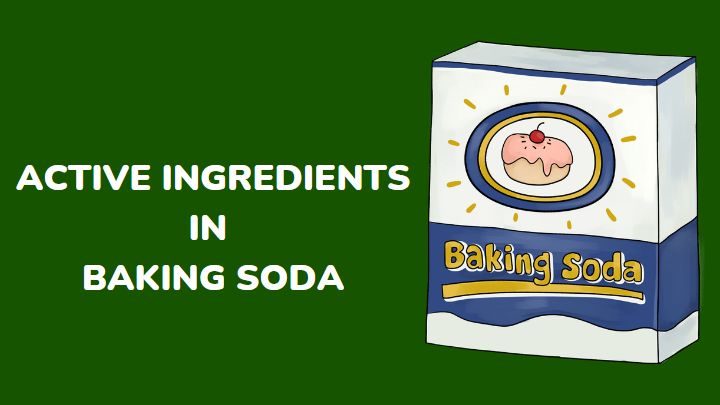Baking soda looks like an ordinary powder but it contains active ingredients which are responsible for its many purposes.
Baking soda is used as a leavening agent for baking, for cleaning tough stains, as medicine, and more. The active ingredients in baking soda are made of molecules of carbon, sodium, hydrogen, and oxygen.
Read on to see what roles each active ingredient plays in baking soda.
What is baking soda?
Baking soda, also known as sodium bicarbonate, is a chemical compound that contains two active ingredients, sodium cation (Na+) and a bicarbonate anion (HCO3−).
The sodium cation is a monatomic monocation that functions as a metabolite. Bicarbonate, on the other hand, is an anion that reacts with acids to produce carbon dioxide.
Additionally, sodium bicarbonate or baking soda is a crystallized white solid that often appears as a fine powder. It has a fairly salty and alkaline taste which is similar to sodium carbonate.
Uses of baking soda
Baking soda has a variety of uses both in the kitchen and outside the kitchen. Here is a list of the many uses of baking soda
1. Cooking
Baking soda is an excellent leavening agent. In baking, it is mixed with acidic ingredients like buttercream, cream of tartar, and lemon juice.
When mixed with these ingredients, baking soda triggers the release of carbon dioxide to make batters expand. It is the ingredient responsible for light and fluffy cakes and bread.
2. Cleaning agent
Sodium bicarbonate is an effective cleaning agent. It is used in soda blasting to remove paints and corrosion from aluminum, copper, and timber. It is also used to remove rust from steel and silver pieces.
Additionally, baking soda is added to soaps as a deodorant and stain removal. The active ingredients in baking soda make it an effective coffee and tea stain remover. Car washes also use baking soda as a water softener.
3. Fire extinguisher
Sodium bicarbonate can help quench grease or electrical fire in your home. Throw the baking soda over the fire and the carbon dioxide released will extinguish the fire.
It is also used in large-scale fire suppression systems in commercial kitchens. The alkaline ingredients in baking powder have a mild saponification effect on hot grease and form a soapy foam when used as an extinguisher.
However, be careful when using it with fires from deep fryers because the gas released can cause the oil to spatter.
4. Disinfectant and odor removal
Baking soda acts as an effective odor-removal and mild disinfectant. It’s potent for cleaning the mouth and gums, neutralizing acid production in the mouth, and preventing infections as an antiseptic.
Perfume-making brands mix sodium bicarbonate with other materials to make deodorants. In addition, it absorbs the musty odor from fridges and books.
5. Medical and health uses
Drug makers find sodium bicarbonate effective for treating acid indigestion and heartburn when mixed with water. It’s also added to local anesthetics to make injections or surgery less painful and speed up the effect of injections.
Doctors use it to treat hyperkalemia, aspirin overdose, and tricyclic antidepressant overdose. It’s also effective in relieving swelling or pains from insect bites and stings. Baking soda is used in eye clinics to treat blepharitis too.
6. Agriculture
Baking soda is associated with the prevention of fungi growth in plants. However, excessive use can result in the discoloration of fruits and loss of chlorosis.
How much baking soda should you use for baking?
Use 1/4 teaspoon of baking soda per 1 cup of baking flour.
Baking soda vs baking powder
Baking soda and baking powder are both leavening agents but they have different compositions and react differently.
The former must react with an acidic ingredient to release carbon dioxide. On the other hand, baking powder is a mix of baking soda, cream of tartar, and sometimes cornstarch.
Moreover, baking soda is at least three times stronger than baking powder but this doesn’t mean adding a lot of it to your batter will make it rise even more.
Any baking recipe requires less baking soda compared to baking powder. Baking soda reacts once when it comes in contact with acid. In contrast, baking powder has components that react at every baking stage.
Does baking soda expire?
Yes, it does. Baking soda has a shelf life of 3 months. After this period, it may lose its ability to react with an acid. So, label your baking soda with dates so you can always check from time to time.
You can also test to know if your baking soda has expired. Pour 3 tablespoons of white distilled vinegar into a bowl, add ½ teaspoon of baking soda, and stir lightly. If the mixture bubbles, then the soda hasn’t expired. If otherwise, it is expired.
FAQs
Is baking soda healthy?
Yes. It is used as an antacid for treating indigestion, heartburn, and blepharitis.
What are the side effects of too much baking soda?
Taking sodium bicarbonate in excess is poisonous and can lead to constipation, convulsion, diarrhea, and irritability.
Where does sodium bicarbonate come from?
Sodium bicarbonate is made from soda ash.
What is the pH of baking soda?
It has a pH of 8, which makes it alkaline.
Conclusion
Baking soda has sodium and bicarbonate as active ingredients. These molecules are combined in proportions to form a fine powder called baking soda. It is used in cooking, cleaning, personal and health care, and agriculture.
When cooking, baking soda acts as a leavening agent in the batter. However, baking soda is a base and must be mixed with an acid component like cream of tartar, honey, buttercream, and yogurt.
In addition, baking soda is not the same as baking powder.
I hope this article was helpful. Thanks for reading.
Read more insightful articles like this on Millenora.

